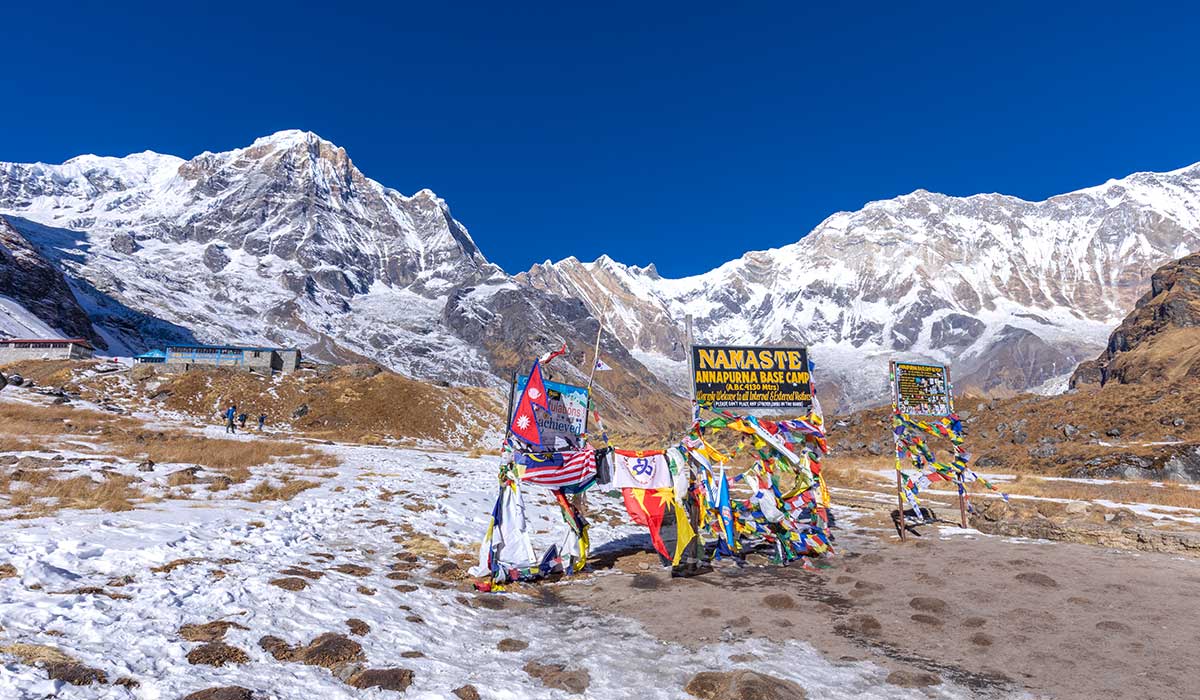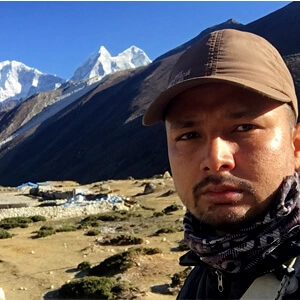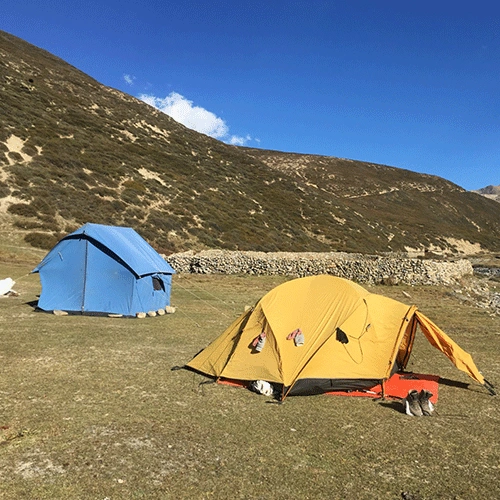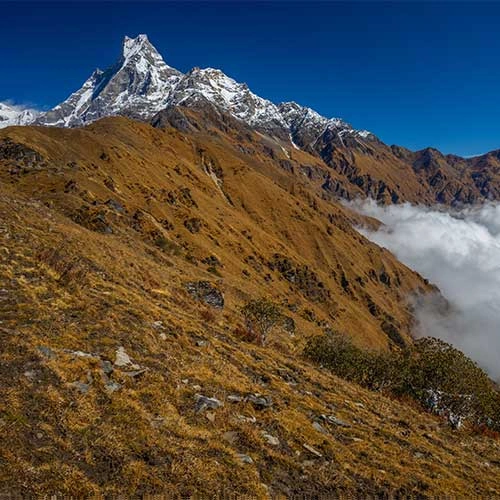Factors Influencing the Difficulty of the ABC Trek
Length and Duration of the Trek
The Annapurna Base Camp Trek has a standard duration of around 13 days. In general, you will spend about ten days on the mountain and cover an approximate trekking distance of 110 km (68 miles). This is a two way trekking distance and you will need to walk for about 5 to 6hours each day of the trek on this classical route.
Even if the trekking distance during each day’s trek is not major, you will still need a good amount of physical strength to walk consistently for such long hours. Traversing across the varying terrain for several days requires good stamina and determination prospects.
Altitude and Acclimatization Challenges
Another Annapurna Base Camp Trek difficulty factor that you have to prepare for is the altitude and acclimatization challenges. This is a high altitude trek and with the rise in elevation along the trip there is also a rise in the potential risk of AMS (Acute Mountain Sickness).
During this base camp adventure, you will reach the highest elevation point of the trek at Annapurna Base Camp (4,130m/ 11,250ft). Compared to other high-altitude base camp and circuit trekking adventures, the elevation gain is not that major.
However, there are risks of suffering from altitude sickness after crossing 2,500 meters (8,202 feet) in altitude without proper acclimatization. So, moving along with a proper acclimatization schedule and getting enough rest along the way is necessary to mitigate the risks of altitude sickness.
Terrain and Trail Conditions
If this is your first time trekking in the Himalayas, it is important to understand the terrain and trail conditions. During your trek you will need to move across many steep ascents and descents on the mountain route. Similarly, you will also need to walk across the stone staircases, rocky paths, river crossings, uneven trails, tricky sections, etc.
Moving across the diverse and challenging trails is a physically taxing endeavor. If you are not physically capable of handling such diverse trail conditions, it can significantly affect your overall trekking experience.
Weather and Seasonal Challenges
The weather factor is another major Annapurna Base Camp Trek difficulty aspect of this Himalayan trek. Depending on the season of your choice, you will have to deal with varying climates and trail conditions. Peak travel periods, like spring and autumn, have the most suitable climate and comfortable trail conditions.
But, off-traveling points like autumn and winter present different challenges due to their unfavorable climatic conditions. Winter has cold freezing temperatures and the trails at the higher altitudes are covered in snow. As for the monsoon the continuous rainfall makes the trail more challenging and the itinerary plans may get disrupted due to unpredictable weather.
Thus, to avoid any kind of weather-related complications, it will be best to join the trails of this classical base camp adventure during the ideal season.
Physical Fitness Requirements for ABC Trek
Annapurna Base Camp Trek is a moderate-scale trekking adventure in the Himalayas. Compared to other high altitude elevators in this classic the ABC Trek is on a relatively easier scale due to its low elevation point and less taxing trekking trail. However, you will still need a basic fitness level and adequate preparation to secure a comfortable experience during the trek.
You can schedule the overall training period for the trek depending on your fitness level. Although the standard recommended preparation period for a Himalayan journey of such caliber is around 3 to 6 weeks, you can shorten or extend the program after assessing your fitness.
If you have exercise habits, you can just emphasize the training programs that help you deal with the high-altitude nature of the trek and the challenging steep trail conditions.
Types of Exercises to Prepare for the Trek
To take on the high-altitude and diverse mountain terrains, you will need a good strength and endurance level. These aspects will determine your overall capabilities to handle the mountain terrains and walking for long hours carrying your backpack. You can do exercises such as push-up, plank, squat, pull-up, squat, lunge, power training, etc, to improve your strength and stamina level.
Similarly, stamina and cardiovascular exercises improve your body’s capability to perform tasks with less fatigue. They are also very helpful for the acclimatization procedure as they make the oxygen handling capacity of the body much easier at higher altitudes.
Beyond those, balance and stretching exercises make traversing across the diver terrain on the mountain a seamless experience. These exercises also reduce muscle tightness and reduce the risks of strain and injury during your trek.
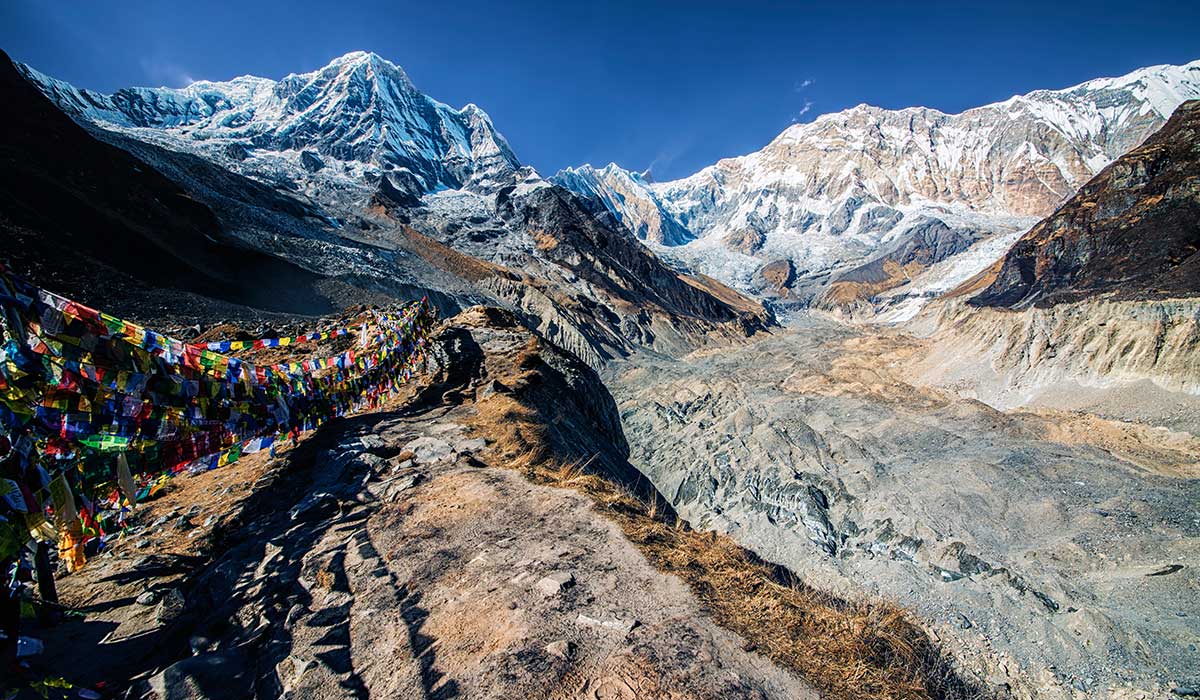
Altitude-Related Challenges on the Annapurna Base Camp Trek
Key Altitudes Along the Trek
There are four major points above the altitude of 2,500 meters (8,202 feet) on this classical Annapurna Bse Camp Trek. As there is a risk of catching altitude sickness above this altitude point, you will have to be careful during your trekking part to these points.
Key Altitude Points in Annapurna Base Camp Trek
- Ghorepani (2,630m/ 8,626ft)
- Poon Hill (3,210m/ 10,528ft)
- Deurali (3,230m/ 10,597ft)
- Annapurna Base Camp (4,130m/ 11,250ft)
Only the actual base camp is near the alpine zone and the rest of the three high points are beneath it. Thus, due to the lack of alpine and challenging factors, traversing to these high points on the trail won’t be a challenge. But, precaution is still necessary.
Risks of Altitude Sickness and Prevention Tips
For incredible adventures in the Himalayan region, there are three types of altitude sickness that you need to be careful about. Each altitude sickness has its own symptoms and emergency scale, which will determine the fate of the adventurer. Here is what you need to understand about the different types of altitude sickness.
- Acute Mountain Sickness (AMS): mild form; fatigue, insomnia, shortness of breath, headache, nausea, dizziness etc
- High Altitude Pulmonary Edema (HAPE): a severe condition when fluid accumulates in the lungs; persistent cough, breathlessness even during rest, rapid heart rate, swelling of hands, feet and face, etc
- High Altitude Cerebral Edema (HACE): a life-threatening condition where the brain starts to swell; confusion, slurred speech, seizures, loss of consciousness, vomiting, etc
As this trek takes place below the alpine zone, the only Annapurna Base Camp Trek difficulty factor regarding altitude gain you have to worry about is Acute Mountain Sickness (AMS). This is a mild form and can be prevented/treated quite easily compared to other forms of altitude sickness.
Acclimatization Tips and Strategies
- Follow a strategic acclimatization schedule before heading to higher altitudes
- Walk slowly and take sufficient short breaks along the way so you don’t over-exhaust yourself
- Drink enough water throughout the trek (at least 3 to 4 liters per day is recommended)
- Eat a healthy and balanced diet, which is very crucial for long hours of physically demanding trekking
- Monitor your health and body language, don’t overlook the symptoms of altitude sickness
- Wear appropriate clothing and keep yourself warm at the higher altitudes
- Avoid alcohol, caffeine, and cigarettes if possible; they are known to affect the acclimatization process
Seasonal Difficulty Variation
As we have discussed earlier, weather is a major contributing factor to the Annapurna Base Camp Trek difficulty. Depending on your preference, you may have to deal with an extra set of challenges during your trip. The months like April, March, May (spring), or September, October and November (autumn) are the most favorable periods for high-altitude adventures in Nepal.
During these periods, the weather is pleasant, the trails are comfortable, the temperatures are just right, the views are extraordinary and there are also tons of culturally enriching prospects. If you schedule your trip during these periods, you won’t have to deal with any additional challenges during your Himalayan trek.
Temperature of Annapurna Base Camp in Spring (March to May): 5°C to 15 °C (can drop to 0°C to -5°C during the night)
Temperature of Annapurna Base Camp in Autumn (September to November): 11°C to 20°C (can drop to -6°C to -10°C during the night)
Challenges of Trekking in Off Period
If you are planning this trek during the off-travel periods like June, July, August (monsoon), or December, January and February (winter), you will need to make extra preparations to counter the unfavorable weather. The monsoon season is the summer period in the country when the temperature rises to its peak.
Similarly there is continuous rainfall that makes the trekking trail challenging and triggers natural disasters like flooding and landslides. That's why you will need to stay updated with the weather forecast and trail conditions if you are planning to do this trek during this season.
Likely, winter, which is also another off-trekking period in Nepal, when the temperature drops to its lowest. Dealing with extreme cold and trails covered with snow and ice can be physically draining if you are not in good shape. Moreover, the acclimatization process takes more time under the cold climatic conditions.
So, if you want to secure a comfortable experience and don’t want to deal with additional factors of Annapurna Base Camp Trek difficulty, you should consider doing this trek during one of the favorable periods.
Temperature of Annapurna Base Camp in Monsoon (June to August): 16°C to 19°C (up to 3°C at night)
Temperature of Annapurna Base Camp in Winter (December to January): averages around 6°C to 7°C (drops upto 14°C to -20°C)
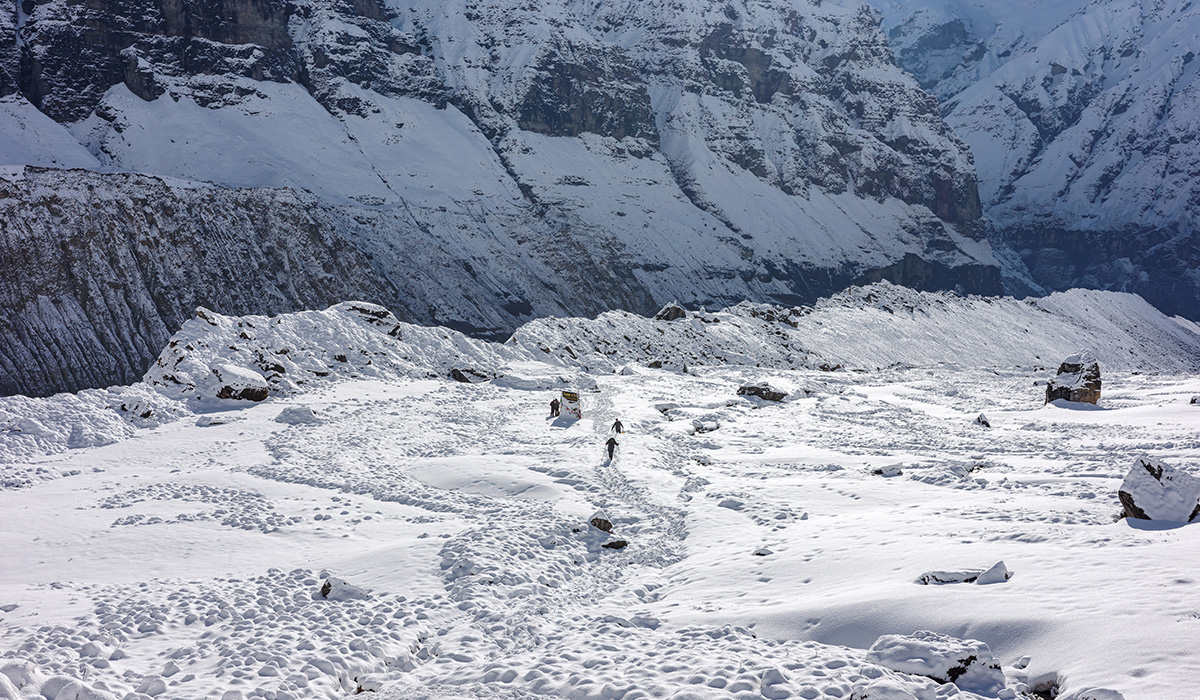
Packing Essentials to Overcome Difficulties
Must-have Trekking Gear
Before starting packing for the Annapurna Base Camp Trek, you need to understand the climatic conditions of that particular month and the climate variation. To make your journey comfortable, you need to understand the most essential gear for this trekking trail.
Trekking equipment such as a backpack, duffle bag, sturdy trekking boot, headlamp, map and guidebook, GPS device, sleeping bag, trekking poles, water bottle, filter/water purification tablet, etc, are very essential for this mountain journey.
Proper Clothing for Varying Weather
For clothing, you need to focus on the appropriate wear for different altitude points along the trail. The higher you climb, the more you will experience a gradual drop in the temperature. So, you need to focus on packing the moisture-wicking thermal tops and tops and insulated mid-layers.
The outer layer should be protective and must be waterproof and windproof. You also shouldn't miss the buff down jacket to deal with the alpine climatic conditions. Similarly, pack gloves, hats, socks and undergarments of different layers to deal with the varying climatic conditions.
You can practice a layering system for your outfit to avoid the hassle of messing with your packing to find convenient clothes.
Other Essentials and Miscellaneous Items
In the other essential category of packing for Annapurna Base Camp Trek, you should prioritize personal items and toiletries. Make sure you have enough supply to last throughout the trek as shopping on the mountain route can be quite costly.
It is also important to carry a small first-aid kit with medicines for general ailments. If you have any kind of personal medication, make sure that you have enough of it to last throughout the trip. Also, packing small lock, power bank, camera, binocular, packing sack, waste bag, portable charger/solar panel, etc can make your journey to the mountain more comforting.
Mental Preparedness for the ABC Trek
Like physical preparation, it is also equally important to mentally preapre for the trek. You will need to have a good level of mental resilience for the Himalayan adventure to deal with the challenges along the trail and move along with the route without losing the determination.
On the long mountain journey, you may need to cope with discomfort, fatigue, isolation factors, or sudden weather changes. Here are some tips that you can follow to stay fully prepared for your Himalayan journey, covering the mental preparation part.
- Have realistic expectations and set the goals in smaller portions
- Cultivate a positive mindset and practice mindfulness
- Focus on the present
- Practice leaving your comfort space
- Acknowledge the potential challenges of the trek
- Visualize your overall journey and you succeeding
- Physical preparation will boost your confidence
- Develop strategies to cope with the setbacks
- Acknowledge your progress, recognize it and reward yourself
Role of Guides and Porters in Reducing Difficulty
It can be tough to manage every aspect of the Annapurna Base Camp Trek difficulty on your own. However, with the support of professional guides and porters, even the most challenging factors of the Himalayan journey won’t feel straining.
Both guides and porters are an integral part of any Himalayan adventure. They offer their service to ensure your safety, comfort and well-being. Guides handle navigation, logistic details, information, your safety and health, assessing risks and so on.
So, trekking with a guide will give you peace of mind and you don’t have to worry about anything about the trip. You can just focus on maximizing your experience. Like guides, porters also offer their valuable service to make your journey a remarkable trip.
Porters carry your luggage to help you travel light. Traveling weight-free will reduce the exhaustion and you will also be able to travel more freely on your Himalayan journey. Thus, the guidance and assistance provided by these personnel will significantly help reduce the difficulty level that you would have to deal with on your own otherwise.
Food and Accommodation Challenges
After the Everest region, Annapurna is the second mainstream Himalayan hub for adventure activities. That’s why, in this classical base camp adventure, you will be able to enjoy a good level of food and accommodation facilities. For the Himalayan treks, there are two to three modes of accommodating facilities depending on the region.
The teahouse is a standard facility for accommodation in the trekking route. If you want a more personalized experience and want private rooms, you can switch to the lodging facilities. The lodges on the trekking route are slightly more expensive than the standard teahouses, but they do offer more extensive services.
Finally, there is also a camping option available if you are looking for a complete outdoor experience. However, it is the most costly accommodation mode for the Himalayan treks as the crew has to carry all the necessary equipment.
Availability and Quality of Food on the Trail
You will also be able to relish a wide range of varieties in this mainstream route for food. The teahouses typically serve a mixture of both traditional meals and international delicacies. For breakfast, the teahouses serve light delights like Museli, Tibetan Bread, Chapati, Toast, Eggs, Oatmeal, Porridge, Pancake, etc.
For lunch and dinner, you can have a pick from filling dishes like Dal Bhat, Noodles, Fried Rice, Pasta, Spaghetti, Soup, Pizza, Burger, Fries, Yak Steak, Tsampa, Gundruk, Dhindo, Momo, Thukpa, Shyakpa, etc. Instead of just going for the taste, you should focus on eating balanced meals and being mindful of the nutrient intake.
A healthy meal will keep your energy level at optimum and will also keep your immune system intact. So, you won’t have to worry about getting sick on the mountain or completely exhausting yourself.
You May Like:Nepali Breakfast: 10 Popular Breakfasts While Trekking In Nepal
Managing Food Allergies or Preferences
Teahouses are very adept at organizing the menus as per the preferences of the customers. So, even if you have an allergy to some ingredients or simply don’t prefer them in your meal, you can make a personal request to the chef to remove those items.
As most of the meals that are prepared are naturally vegetarian, you won’t have issues exploring the traditional cuisine that the Himalayan nation has to offer. Similarly, if you prefer vegan or gluten-free meals, you can make a request with the kitchen staff about your need, though available options in this category may be limited.
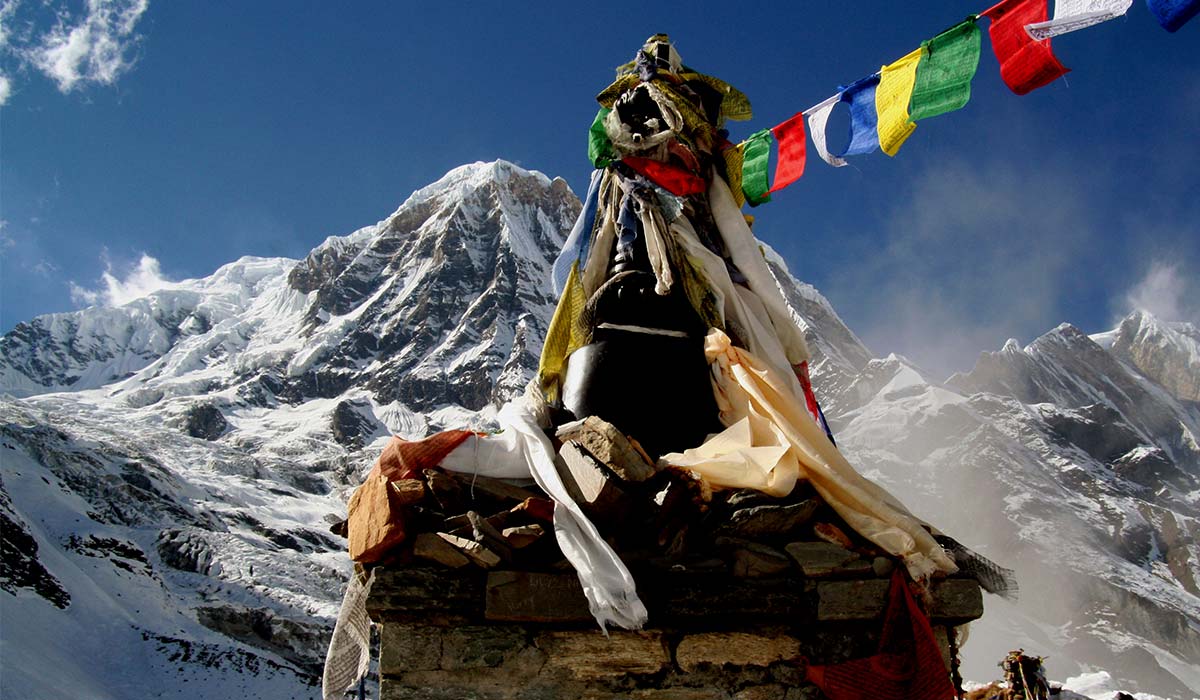
Common Challenges and How to Tackle Them?
Fatigue and Muscle Soreness: Long hours of walking on uneven terrains can lead to physical exhaustion, joint discomfort and tight muscles. Conscious walking without proper rest can elevate fatigue levels. Thus, it is necessary to do proper physical training before the trek. Similarly, make sure to stretch and pace yourself during the trek to avoid muscle cramps.
Dealing With Blisters and Injuries: Blisters are common issues when doing long-haul journeys. That’s why it is very crucial to check the comfort level of boots and shoes to avoid any issues during the trek. Keep your feet dry and air them out; carry blister pads or moleskin to treat the blistered area. Also, for injuries or strain on uneven trails, bring a comprehensive first-aid kit.
Staying Hydrated and Avoiding Dehydration: Dehydration is common due to high altitude dry aid, sweating and insufficient intake of water during the trek. So, make sure to drink 3 to 4 liters of fluid per day. You can also add electrolytes to your water to make up for the lost salt from the body.
Cold Weather and Temperature Drops: If you are not careful, the cold temperatures, especially during the early morning and night, can cause discomfort and hypothermia. Similarly, the sudden change can contribute to the cold temperature at the higher part of the trail. So, a sleeping bag, proper layering of clothes, headgear, scarf, gloves, socks, protective outer shell, etc, are essential to keep yourself comfortable.
Managing Food-Related Fatigue: Limited food of options or loss of appetite due to elevation can lead to inadequate nutrition in the body. This can affect digestion and the overall immune system, causing discomfort and health-related issues. So, you need to eat healthy meals that provide the necessary nutrients throughout your journey.
Tips for Beginners Taking on the Annapurna Base Camp Trek
- Start slow, follow a steady pace and trek regular short breaks, avoid exhausting yourself to cover more distance in a single day
- Build your endurance and confidence level by doing some short acclimatization hikes
- Pack smart and light so you don’t have to exhaust yourself during each day of trek
- Build good physical fitness; the more feat you are, the more easy it will be to deal with Annapurna Base Camp Trek difficulty
- Select a proper trekking package with enough rest and acclimatization period
- Choose the right season for the trek to avoid dealing with unnecessary challenges
- Learn basic first-aid treatment and familiarize yourself with the symptoms of altitude sickness
- Don’t avoid mental preparation; have a positive mindset and be flexible
- Invest in insurance and get a plan that covers for high-altitude treks and emergency evacuation

